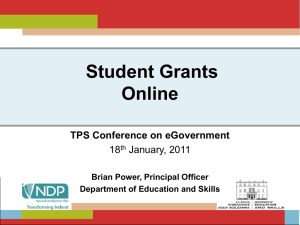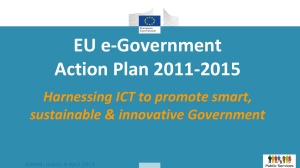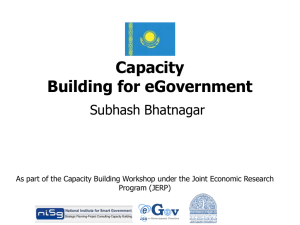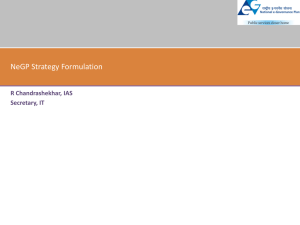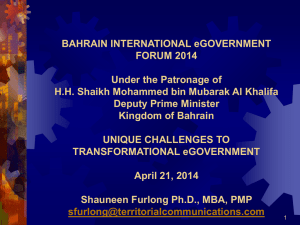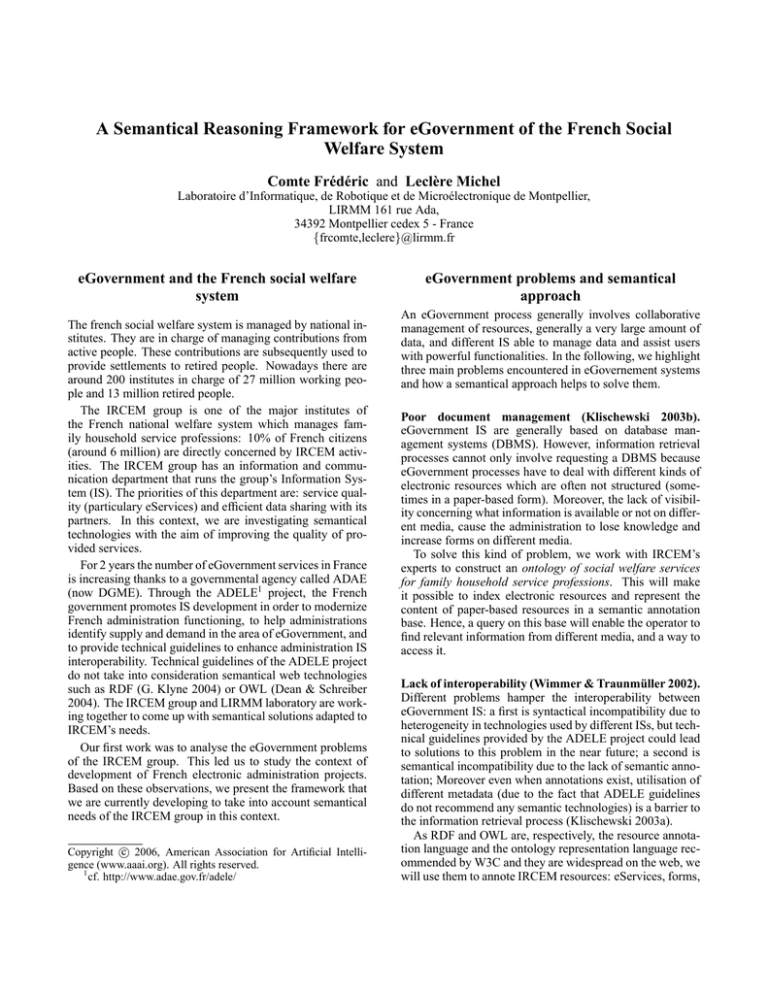
A Semantical Reasoning Framework for eGovernment of the French Social
Welfare System
Comte Frédéric and Leclère Michel
Laboratoire d’Informatique, de Robotique et de Microélectronique de Montpellier,
LIRMM 161 rue Ada,
34392 Montpellier cedex 5 - France
{frcomte,leclere}@lirmm.fr
eGovernment and the French social welfare
system
The french social welfare system is managed by national institutes. They are in charge of managing contributions from
active people. These contributions are subsequently used to
provide settlements to retired people. Nowadays there are
around 200 institutes in charge of 27 million working people and 13 million retired people.
The IRCEM group is one of the major institutes of
the French national welfare system which manages family household service professions: 10% of French citizens
(around 6 million) are directly concerned by IRCEM activities. The IRCEM group has an information and communication department that runs the group’s Information System (IS). The priorities of this department are: service quality (particulary eServices) and efficient data sharing with its
partners. In this context, we are investigating semantical
technologies with the aim of improving the quality of provided services.
For 2 years the number of eGovernment services in France
is increasing thanks to a governmental agency called ADAE
(now DGME). Through the ADELE1 project, the French
government promotes IS development in order to modernize
French administration functioning, to help administrations
identify supply and demand in the area of eGovernment, and
to provide technical guidelines to enhance administration IS
interoperability. Technical guidelines of the ADELE project
do not take into consideration semantical web technologies
such as RDF (G. Klyne 2004) or OWL (Dean & Schreiber
2004). The IRCEM group and LIRMM laboratory are working together to come up with semantical solutions adapted to
IRCEM’s needs.
Our first work was to analyse the eGovernment problems
of the IRCEM group. This led us to study the context of
development of French electronic administration projects.
Based on these observations, we present the framework that
we are currently developing to take into account semantical
needs of the IRCEM group in this context.
c 2006, American Association for Artificial IntelliCopyright gence (www.aaai.org). All rights reserved.
1
cf. http://www.adae.gov.fr/adele/
eGovernment problems and semantical
approach
An eGovernment process generally involves collaborative
management of resources, generally a very large amount of
data, and different IS able to manage data and assist users
with powerful functionalities. In the following, we highlight
three main problems encountered in eGovernement systems
and how a semantical approach helps to solve them.
Poor document management (Klischewski 2003b).
eGovernment IS are generally based on database management systems (DBMS). However, information retrieval
processes cannot only involve requesting a DBMS because
eGovernment processes have to deal with different kinds of
electronic resources which are often not structured (sometimes in a paper-based form). Moreover, the lack of visibility concerning what information is available or not on different media, cause the administration to lose knowledge and
increase forms on different media.
To solve this kind of problem, we work with IRCEM’s
experts to construct an ontology of social welfare services
for family household service professions. This will make
it possible to index electronic resources and represent the
content of paper-based resources in a semantic annotation
base. Hence, a query on this base will enable the operator to
find relevant information from different media, and a way to
access it.
Lack of interoperability (Wimmer & Traunmüller 2002).
Different problems hamper the interoperability between
eGovernment IS: a first is syntactical incompatibility due to
heterogeneity in technologies used by different ISs, but technical guidelines provided by the ADELE project could lead
to solutions to this problem in the near future; a second is
semantical incompatibility due to the lack of semantic annotation; Moreover even when annotations exist, utilisation of
different metadata (due to the fact that ADELE guidelines
do not recommend any semantic technologies) is a barrier to
the information retrieval process (Klischewski 2003a).
As RDF and OWL are, respectively, the resource annotation language and the ontology representation language recommended by W3C and they are widespread on the web, we
will use them to annote IRCEM resources: eServices, forms,
documentation, etc. We will also use them to represent the
ontology. Utilisation of these standards provides syntactical
interoperability but also semantical interoperability thanks
to the formal semantics of these languages defined in (Hayes
2004) and (Patel-Schneider, Hayes, & Horrocks 2004).
Absence of intelligent mechanisms. Passive management of eGovernment data is not sufficient if we consider the
social range of an eGovernment process. If a user submits
a request about law texts, answers from the system have to
be relevant and complete: the process has to guarantee that
answers are correct and that no other relevant answer has
been forgotten (for important requests a forgotten resource
can lead to a very bad legal situation). Besides, an eGovernment IS contains explicit but also implicit knowledge. Implicit knowledge must not be lost but could also be utilized:
a naive example to illustrate this problem is an IS which can
provide the date of birth of a person but cannot answer a
request about the age.
We consider that inferential mechanisms are essential for
eGovernment services and should be characterized formally
in order to guarantee the operational quality of services to
users. To provide these guarantees, we use an Artificial
Intelligence Knowledge Representation (AI KR) formalism
called the SG family (Baget & Mugnier 2001), which is a
subformalism of Conceptual Graphs (CG) (Sowa 1976), logically founded (reasonings being sound and complete w.r.t.
First Order Logic (FOL) semantics).
Semantical Reasoning Framework
Due to the complexity and distributivity of an eGovernment process, it cannot be considered that all information is
known. For this reason, the closed world assumption of classical databases would be too restrictive for an eGovernment
service; we have thus chosen to work under the open world
assumption. The architecture of our semantical framework
is based on a resource-metadata-ontology paradigm: each
IRCEM resource (and those from their collaborators) will be
identified by a unique name and characterised by its metadata. Metadata vocabulary comes from the ontology. This
ontology is a kind of heavyweight ontology allowing complex representations like type definitions or axioms used in
an inferential mechanism or in a validation mechanism.
Figure 1: Semantical reasoning framework
The architecture of the semantical reasoning framework
is mainly composed of (see Figure 1):
• a semantical web portal (SWP) which allows end-users
to acces eServices. In (Comte 2004), we describe SWP
as a common web interface that is able to: (1) display
semantic networks representing metadata, (2) provide a
graphical way to specify requests, and (3) provide direct
acces to resources (electronic). SWP will allow IRCEM
subscribers to retrieve specific eServices (e.g online subscription), specialized law texts, official forms, etc;
• a business plugin providing more extended functionalities
than SWP for IRCEM employees. This plugin will be
integrated in existing IRCEM IS;
• a set of protocols and processes able to
1. import RDF and OWL data into our AI KR formalism;
for reasonings purposes this importation has to preserve
semantics (Baget 2005),
2. link different components of the architecture,
3. share data with different external partners;
• A Logic kernel composed of the domain ontology, the
metadata network and the inference engine.
Inference engine
An inference engine is always dedicated to a particular AI
KR formalism. There are three main criteria to characterize a KR formalism: epistemological criterion, which represents the expressivity of the formalism, computationnal efficiency, and convenience criterion (also called human window or conciseness), which represents the facility to describe something in a KR formalism.
On one hand, Description Logic (DL) (Baader & Nutt
2003), very widespread in the semantic web community,
meets the first two criteria but not the convenience criterion.
From a computational viewpoint, these DL systems are well
designed for terminological inferences, like classification or
realization.
On the other hand, the SG family meets the convenience
criterion because knowledge is represented graphically and
reasonings are graphically performed. This formalism is
well adapted to assertional knowledge (the basic formalism,
i.e. simple graphs, has an expressivity equivalent to RDF/S
formalism (Baget 2005)). In particular, it allows to represent unidentified cyclic knowledge structures which are not
expressable in DL. See for instance the following example
in OWL abstract syntax:
Class(houseHoldProfessional
complete
intersectionOf( Person restriction(workingPlace value :x ))
restriction(workFor intersectionOf( Person someValuesFrom(restriction(live value ( :x ))))) )
At the terminological level, the SG family has representation features that differ from these of DL. For example, DLs
facilitate representation of relation cardinalities, negation or
disjunction, while SG family permits to represent general
axioms of ontologies that can be used as rules or constraints.
Based on graph theory, the SG family benefits from a substantial amount of algorithmic results in this domain.
To be in line with previous criteria, we will develop an
heterogeneous DL-CG system. A DL system will be used
for terminological inferences, while a CG system will be
used for assertional reasonings. Logic kernel offer two kinds
of heterogeneous service (other inferences can be reduced
to these two) for logical data management: information retrieval and annotation validation.
• Information retrieval: Let Q be a query graph, an information retrieval service consists of computing some answer graphs A matching Q, where each a ∈ A is obtained
by deduction from both the annotation base and the ontology. This problem states that information retrieval involves the return of annotations justifying the answers;
• Validation: Is an annotation consistent with a consistent
ontology? This step, which is supervised by the annotator (who is the data resource designer or a knowledge
engineer depending on the context), ensures that annotations are correctly using ontological vocabulary. The annotation is first satured with rules issued from ontological
axioms considered as implicit (thus used in an inferential
way), and then constraints issued from axioms restricting
the validity of the knowledge are checked.
Use of the SG family in a logical kernel allows us to import some results about deduction, information retrieval and
consistency checking services. SG deduction with type definitions was shown to be sound and complete w.r.t. FOL
semantics in (Leclère 1997). Consistency checking of a
knowledge base in this formalism, with finite expansion
rule set, was shown to be decidable in (Baget & Mugnier
2002). These results will allow us to guarantee the operational quality of service for the semantical reasoning framework.
A Logical kernel is currently implemented as an heterogenous DL-CG system. The CG system is based on CoGiTaNT
(Salvat & Genest 1998). We plan to associate it with a DL
system such as RACER (Haarslev & Möller 2001) or FaCT
(Horrocks 1998). SWP and business plugin will be implemented with classical technologies and extended with a version of CoGui, which is a graphical interface for CoGiTaNT.
Further works
User’s could legitimately have high expectations concerning
eGovernment process quality because these processes deal
with personal data. The ADELE project and IRCEM eGovernment problems have led us to investigate, and define, a
kind of guarantee for eGovernment services that we call operational quality of service. This guarantee will contribute
to an ADELE imperative, to: “set up a pact of trust with
French people”.
In further works, we will have to investigate potential erroneous annotations: a reparation service will be useful to
repair these annotations in a semi-automatic way (collaboration with a supervisor). Finally, through user tests, we also
plan to compare the convenience of keyword/formulary requests and semantic network requests.
References
Baader, F., and Nutt, W. 2003. The Description Logic
Handbook. Cambridge press. chapter 2, Basic Description
Logics.
Baget, J.-F., and Mugnier, M.-L. 2001. The SG Family: Extensions of Simple Conceptual Graphs. In Proc.
IJCAI’01, volume 1, 205–210.
Baget, J.-F., and Mugnier, M.-L. 2002. The complexity of rules and constraints.
JAIR 16:425–465.
http://www.jair.org/abstracts/baget02a.html.
Baget, J. F. 2005. Rdf entailment as a graph homomorphism. In ISWC, volume 3729 of LNCS, 82–96.
Comte, F.
2004.
Un portail sémantique pour
la e-administration.
Groupe des Ecoles de
Télécommunications. GET.
Dean, M., and Schreiber, G. 2004. Owl web ontology
reference. Technical report, W3C.
G. Klyne, J. C. 2004. Resource description framework
(rdf): Concepts and abstract syntax. Recommandation,
W3C.
Haarslev, V., and Möller, R. 2001. RACER system description. Lecture Notes in Computer Science 2083.
Hayes, P. 2004. Rdf semantics. Recommandation, W3C.
Horrocks, I. 1998. Using an expressive description logic:
FaCT or fiction? 636–647.
Klischewski, R. 2003a. Semantic web for e-government.
In EGOV 2003, 288–295. Springer Verlag Berlin.
Klischewski, R.
2003b.
Towards an ontology for
e-document management in public administration. In
CACM45, 48–54.
Leclère, M. 1997. Reasoning with type definitions. In
Proc. ICCS’97, volume 1257 of LNAI, 401–415. Springer.
Patel-Schneider, P.; Hayes, P.; and Horrocks, I. 2004.
Owl web ontology language semantics and abstract syntax.
Recommandation, W3C.
Salvat, E., and Genest, D. 1998. A plateform allowing typed nested graph: how cogito became cogitant. In
springer verlag LNAI, volume 1453, 154–161.
Sowa, J. F. 1976. Conceptual Graphs. IBM Journal of
Research and Development.
Wimmer, M., and Traunmüller, R. 2002. Towards an integrated platform for online one-stop government. In ERCIM
news, volume 48, 14–15.

